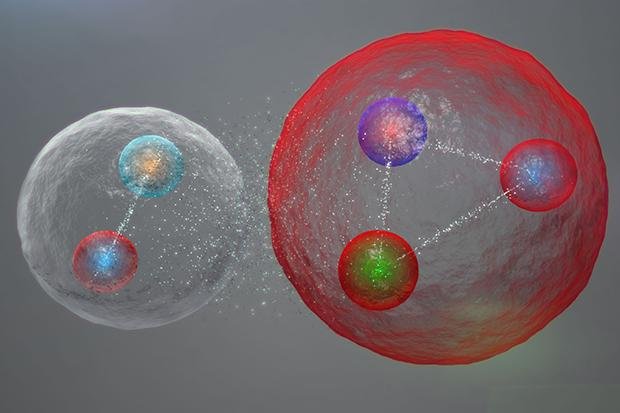Researchers have confirmed the existence of two rare five-quark hadron particles. Photo by Syracuse University
GENEVA, Switzerland, July 14 (UPI) -- Researchers have confirmed the existence of two pentaquark states, rare subatomic particles made up of five quarks. The discovery has major implications for the quest to understand the mysterious building blocks of matter.
The confirmation was based on analyzed data collected using the CERN Large Hadron Collider, a massive tool that smashes particles together at high energies.
"The statistical evidence of these new pentaquark states is beyond question," Sheldon Stone, a physics professor at Syracuse University and one of the latest experiments' leading engineers, explained in a press release. "Although some positive evidence was reported around 10 years ago, those results have been thoroughly debunked. Since then, the LHCb [Large Hadron Collider beauty] collaboration has been particularly deliberate in its study."
Quarks are the elementary particles that make up well-studied subatomic particles like neutrons and protons, which each feature three quarks. Combinations of quarks are known as hadrons. More stable hadrons, like protons and neutrons, are called baryons, where as less stable (and less common) hadrons with four quarks are known as mesons.
Particle physicists have long theorized the existence a five quark particle, but had been previously unable to locate hard evidence.
"Benefitting from the large data set provided by the LHC, and the excellent precision of our detector, we have examined all possibilities for these signals, and conclude that they can only be explained by pentaquark states," added LHCb physicist Tomasz Skwarnicki of Syracuse University. "More precisely the states must be formed of two up quarks, one down quark, one charm quark and one anti-charm quark."
Quarks don't exist in isolation and can't be directly observed. Instead, researchers must estimate their existence by observing the behavior of hadrons. But isolating the revealing behavior in the atomic chaos of colliding particles isn't easy.
But that's part of what makes work with LHC so exciting -- each new round of experiments seems to yield new discoveries. Not long ago, the collider helped scientists observe what they believe to be the Higgs Boson, the so-called God particle which gives other fundamental particles their mass. Soon, researchers will begin using the collider to search for direct evidence of "dark matter," particles that explain the existence of black holes.
Stone says all these new discoveries should be credited to his and his colleagues' predecessors, the particle physicists who laid the parameters for an understanding of the Standard Model of physics -- specifically Murray Gell-Mann, the Nobel prize-winning physicist who first posited the existence of quarks.
"He predicted that strongly interacting particles [hadrons] are formed from quark-antiquark pairs [mesons] or from three quarks [baryons]," Stone said. "This classification scheme, which has grown to encompass hadrons with four and five quarks, underscores the Standard Model, which explains the physical makeup of the Universe."
As is always the case in science -- or any human endeavor, for that matter -- the latest answer yields more questions, chiefly: how do quarks bind to each other?
The leading theory is that a mechanism called residual nuclear force pulls quarks together at a strength 10 million times more powerful than chemical bonds. But more work must be done to illuminate this theory.
"The theory of strong interactions is the only strongly coupled theory we have," Stone said. "It is particularly important for us to understand, as it not only describes normal matter, but also serves as a precursor for future theories."















